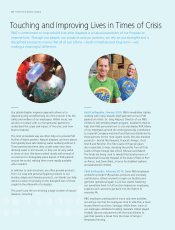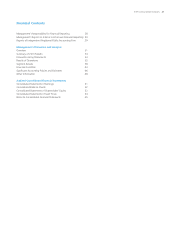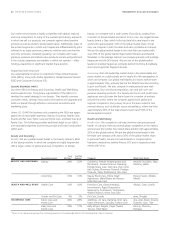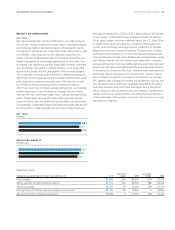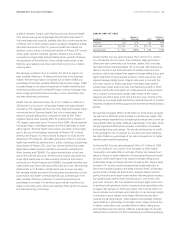Proctor and Gamble 2010 Annual Report Download - page 33
Download and view the complete annual report
Please find page 33 of the 2010 Proctor and Gamble annual report below. You can navigate through the pages in the report by either clicking on the pages listed below, or by using the keyword search tool below to find specific information within the annual report.The purpose of this discussion is to provide an understanding of
P&G’s financial results and condition by focusing on changes in
certain key measures from year to year. Management’s Discussion
and Analysis (MD&A) is organized in the following sections:
• Overview
• Summary of 2010 Results
• Forward-Looking Statements
• Results of Operations
• Segment Results
• Financial Condition
• Significant Accounting Policies and Estimates
• Other Information
Throughout MD&A, we refer to measures used by management to
evaluate performance, including unit volume growth, net sales and
net earnings. We also refer to a number of financial measures that
are not defined under accounting principles generally accepted in the
United States of America (U.S. GAAP), including organic sales growth,
core earnings per share (Core EPS), free cash flow and free cash flow
productivity. Organic sales growth is sales growth excluding the
impacts of foreign exchange, acquisitions and divestitures. Core EPS is
diluted net earnings per share from continuing operations excluding
certain specified charges. Free cash flow is operating cash flow less
capital spending. Free cash flow productivity is the ratio of free cash
flow to net earnings. We believe these measures provide investors
with important information that is useful in understanding our busi-
ness results and trends. The explanation at the end of MD&A provides
more details on the use and the derivation of these measures.
Management also uses certain market share and market consumption
estimates to evaluate performance relative to competition despite
some limitations on the availability and comparability of share and
consumption information. References to market share and market
consumption in MD&A are based on a combination of vendor-reported
consumption and market size data, as well as internal estimates. All
market share references represent the percentage of sales in dollar
terms of our products relative to all product sales in the category. In
certain situations, we discuss volume share, which is the percentage of
unit volume of our products relative to all products sold in the category.
Recent Business Developments
In October 2009, we sold our global pharmaceuticals business to
Warner Chilcott plc (Warner Chilcott) for $2.8billion, net of assumed
and transferred liabilities. Under the terms of the agreement, Warner
Chilcott acquired our portfolio of branded pharmaceuticals products,
our prescription drug product pipeline and our manufacturing facilities
in Puerto Rico and Germany. The pharmaceuticals business had histori-
cally been part of the Health Care reportable segment. In accordance
with the applicable accounting guidance for the disposal of long-lived
assets, the results of our pharmaceuticals business are presented as
discontinued operations and, as such, have been excluded from con-
tinuing operations and from segment results for all periods presented.
Effective July 2009, we implemented a number of changes to our
organization structure for the Beauty Global Business Unit (GBU),
which resulted in changes to the components of its segment structure.
As a result, the Beauty GBU became the Beauty and Grooming GBU
and reportable segments under the GBU moved to a new consumer-
oriented alignment. The two reportable segments within the Beauty
and Grooming GBU continue to be Beauty and Grooming. However,
female blades and razors transitioned from Grooming to Beauty. In
addition, certain male-focused brands and businesses, such as Old
Spice and Gillette personal care, moved from Beauty to Grooming.
These changes have been reflected in our segment reporting begin-
ning in fiscal year 2010. Our historical segment reporting, including
both the MD&A and footnotes to the accompanying Consolidated
Financial Statements for the years ended June30, 2009 and 2008,
has also been restated to reflect the new structure.
In November 2008, we completed the divestiture of our coffee
business through the merger of our Folgers coffee subsidiary into
The J.M. Smucker Company (Smucker) in an all-stock reverse Morris
Trust transaction. In connection with the merger, 38.7million shares
of P&G common stock were tendered by our shareholders and
exchanged for all shares of Folgers common stock. Pursuant to the
merger, a Smucker subsidiary merged with and into Folgers and
Folgers became a wholly owned subsidiary of Smucker.
The coffee business had historically been part of the Company’s
Snacks, Coffee and Pet Care reportable segment, as well as the coffee
portion of the away-from-home business which was included in the
Fabric Care and Home Care reportable segment. In accordance with
the applicable accounting guidance for the disposal of long-lived
assets, the results of our coffee business are presented as discontin-
ued operations and, as such, have been excluded from continuing
operations and from segment results for all periods presented. The
Snacks, Coffee and Pet Care reportable segment was renamed Snacks
and Pet Care to reflect this change.
OVERVIEW
Our business is focused on providing branded consumer packaged
goods of superior quality and value to our consumers around the
world. This will enable us to execute our Purpose-inspired growth
strategy: to touch and improve more consumers’ lives, in more parts
of the world, more completely. We believe this will result in leadership
sales, earnings and value creation, allowing employees, shareholders
and the communities in which we operate to prosper.
Our products are sold in more than 180 countries primarily through
mass merchandisers, grocery stores, membership club stores, drug
stores and high-frequency stores, the neighborhood stores which
serve many consumers in developing markets. We continue to
expand our presence in other channels, including department stores,
perfumeries, pharmacies, salons and e-commerce. We have on-the-
ground operations in approximately 80 countries.
Management’s Discussion and Analysis
The Procter & Gamble Company 31







